I have been following examples on stack to create Sankey charts using the NetworkD3 package. I would like to set the colour of the links specific to column variables event. The data that I have has multiple columns:
structure(list(names = c("bell", "john", "andrew", "sam", "bell",
"bell", "andrew"), event = c("Event 1", "Event 2", "Event 3",
"Event 1", "Event 2", "Event 4", "Event 1"), response = c("Yes",
"Yes", "No", "Yes", "No", "Yes", "No")), class = "data.frame", row.names = c(NA,
-7L))
> d
names event response
1 bell Event 1 Yes
2 john Event 2 Yes
3 andrew Event 3 No
4 sam Event 1 Yes
5 bell Event 2 No
6 bell Event 4 Yes
7 andrew Event 1 No
Following CJ Yetman's example (thank you very much for the very followable example if you ever read this!) here, data frames for the links and nodes were created:
links <- d %>%
mutate(row = row_number()) %>%
gather('column', 'source', -row) %>%
mutate(column = match(column, names(d))) %>%
group_by(row) %>%
arrange(column) %>%
mutate(target = lead(source)) %>%
ungroup %>%
filter(!is.na(target)) %>%
#index
mutate(source = paste0(source, '_', column)) %>%
mutate(target = paste0(target, '_', column + 1)) %>%
select(source, target)
nodes <- data.frame(
name=c(as.character(links$source), as.character(links$target)) %>%
unique()
)
Then I matched the indices in the nodes data frame to the source and target columns in the links data frame. In this case, I mutated new columns rather than overwriting it because it is easier for me to read:
link <- links %>%
mutate(IDsource = match(links$source, nodes$name)-1) %>%
mutate(IDtarget = match(links$target, nodes$name)-1) %>%
mutate(value = 1) %>%
#remove index
mutate(source = sub('_[0-9]+$', '', source)) %>%
mutate(target = sub('_[0-9]+$', '', target))
#
nodes$name <- sub('_[0-9]+$', '', nodes$name)
As mentioned, I would like to set the colour of the links across the entire flow of the Sankey diagram by event. Here specifies creating a new column in links and nodes to match the colour scale specified in the d3.scaleOrdinal() function.
#New column to set colour for nodes
nodes$node.col <- as.factor(c("nod.col")) #set nodes to one colour only
#New column for links
col.index <- d %>%
select(event) %>% unique(); col.index #get events from original dataframe
#mutate new column to set colours for links
links$links.col <- col.index$event[match(links$source, col.index$event)]
links$links.col[is.na(links$links.col)] <- col.index$event[match(links$target[is.na(links$links.col)], col.index$event)]
links$links.col <- as.factor(links$links.col) #change to factors
#d3.scaleOrdinal()
my_color <- 'd3.scaleOrdinal() .domain(["Event 1", "Event 2", "Event 3", "Event 4", "nod.col"]) .range(["red", "blue", "red", "yellow", "gray"])'
However, the links are all red, when each event should have its own colour (across the entire flows).
sankeyNetwork(Links = links, Nodes = nodes, Source = 'IDsource',
Target = 'IDtarget', Value = 'value', NodeID = 'name', colourScale=my_color,
LinkGroup="links.col", NodeGroup="node.col")
Could someone explain what I did wrong? The other issue I have is with manually setting the colours for each event in d3.scaleOrdinal(). If there an efficient way to do this I need to set the colour for up to 30 or more events?

